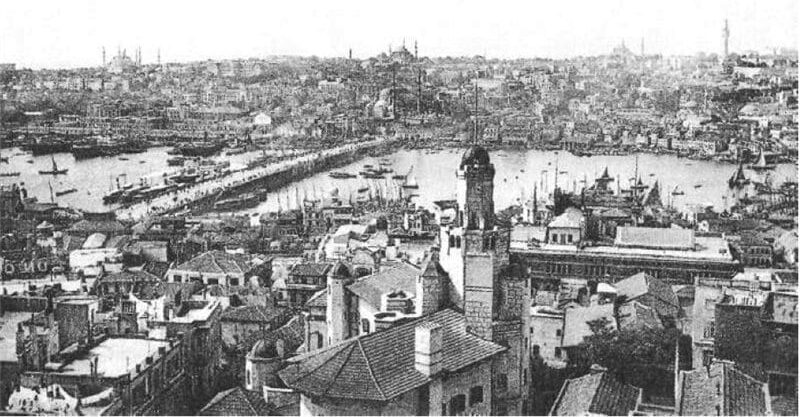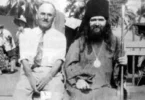Part I. Chapter 2
From the Time of the Evacuation of the SEA until the Resettlement
in Sremsky-Karlovtsy (November 1920 – July 1921)
At the beginning of November 1920, the Red Army had almost entirely conquered the White Russian territory in the south. The remnant of the White Army left the Crimea on 6/19 November. On 125 ships – including 66 warships and 9 passenger ships – 150,000 people evacuated. The remainder of these refugees consisted of some 100,000 soldiers, 20,000 women, and approximately 7,000 children. The rest of the refugees included thousands of people who had been a part of the old administration and government: officials, office workers, teachers, professors, as well as clergy, monks and nuns. [1] Nikon, Zhizneopisanie, 5:5.
The exact number of Russian emigres after World War I has never been precisely established. Estimates vary between one million and two and a half million. This wide discrepancy indicates that the authorities in the countries which harbored them, and later the refugee organization of League of Nations, undertook census registrations at different times. One example may clarify this: The “German-Russian Union” in May of 1919 counted 60,000 – 80,000 Russian refugees who had left their homeland before the end of the Civil War. [2] Volkmann, p. 4. In December of 1920, the German section of the American Red Cross counted 560,000 Russians in Germany, while other censuses spoke of 300,000 emigres. [3] Ibid, p. 5. Many of these emigres traveled to other countries after a stay of only a few weeks. Their ranks swelled at the outbreak of the 1921 famine in the Soviet Union, so that in 1921 the Russian Archive in Prague gave the number of Russians in Germany as 230,000 – 250,000, while by contrast, in Germany the Ministry of State for the Interior (Reichsministerium des Inneren) only listed 50,000 – 80,000. [4] Ibid. These statistics in Germany alone, which played a special role as a place of transit for many emigres, give an indication of how difficult the counting of Russian refugees was.
For the year 1928, there is a count by “The Refugee Inspection of the International Labor Office of the League of Nations,” which numbered the Russian emigres in the world at 919,000. The Refugee Inspection of the International Labor Office of the League of Nations divided the Russian refugees in each country as follows: [5] Ibid, p. 6.
France 400,000
Germany 150,000
Poland 90,000
China 76,000
Latvia 40,000
Yugoslavia * 36,380
Czechoslovakia 30,000
Bulgaria 26,494
Lithuania 10,000
Other Countries 20,000
*Kingdom of the Serbs, Croats, & Slovenes
This list omits completely, for example, the U.S.A., Africa, and Asia. In Manchuria alone, 120,000 –160,000 Russians lived; they were not included in the list of the League of Nations. [6] Seide, ROK in China, p. 182. If one adds these refugees, and especially those who then lived in the U.S.A. and in South America, to the International Labor Office of the League of Nations list, at the end of the 1920s there would have been well over one and a half million Russians who had left their homeland since 1917 and lived outside of the Soviet Union. [7]A whole series of autocephalous Orthodox Churches, including the ancient Patriarchates of Constantinople, Alexandria, Jerusalem and Antioch, the Orthodox churches in Poland, Czechoslovakia and the … Continue reading
The greater part of these refugees came from those areas that were traditionally Orthodox. If one considers that among the refugees there were also very many who were not attached to the Church, then one can count the Orthodox emigres at over one million. This large number alone justifies its own ecclesiastical administration for the care of the faithful who found themselves in non-Orthodox countries.
The first session of the evacuated SEA took place on 6/19 November 1920, aboard the ship “The Grand Duke Alexander Mikhailovich”, during the crossing to Constantinople. At this session the following hierarchs, who sailed with the flotilla, took part: Metropolitan Anthony, Metropolitan Platon of Kherson and Odessa, Archbishop Theophanes of Poltava and Pereyaslav, Bishop Benjamin of Sevastopol, head of the military chaplains on land and at sea, [8] Compare the biographies of these hierarchs in Part VI. and Archpriest G. Spassky. The participants in this session decided that the SEA should be concerned with the future religious needs of the many refugees in the “various parts of the world,” because the refugees desired to have no further relations with Soviet Russia and were unable to establish any contact with the remnant of the Holy Synod headed by the Patriarch. The seat of the SEA should be in Constantinople; therefore, official contact with the Patriarch of Constantinople should be established. This ecclesiastical body should, by summoning other members, be expanded, and all ways and means should be exhausted to inform Patriarch Tikhon of the establishment of this organization. A further session of the Synod was to take place in Constantinople on 9/22 November. [9] Nikon, Zhizneopisanie, 5, pp. 6-7. Among these initial decisions, the SEA’s promise to care for all the refugees in the world was significant. This declaration was also cosigned by Metropolitan Platon, who later renounced the Synod of Bishops’ jurisdiction over North America.
In the next session, which took place in Constantinople, Archbishop Anastasius became a member of the Ecclesiastical Administration. At the session of 16/29 November, Metropolitan Anthony and Bishop Benjamin were assigned the task of establishing official relations between the SEA and the Ecumenical Patriarch. [10] Ibid., p. 8.
On 22 December 1920, the Ecumenical Patriarchate issued the Decree No. 9084, in which he granted the Russian bishops full authority to order the ecclesiastical and religious problems of the Russian emigres on the territory of the Patriarch’s jurisdiction. This full authority gave the Russian hierarchs a virtually autonomous status in ordering their Church life. The Patriarchate, however, retained oversight and the sole competence to rule on the divorces of Russian faithful. In practice, the Russian bishops in Constantinople administered the Russian communities completely independently of the Patriarch and considered the area as their own diocese at the head of which stood Archbishop Anastasius, who had been the representative of the SEA since the autumn of 1920. In the immediate vicinity of the capital, there were over twenty churches in the Russian camps; another ten churches were on the island of Lemnos; and in Gallipoli, where a portion of the refugee soldiers were quartered.
The SEA maintained its official seat in Constantinople for approximately half a year, from November of 1920 through May of 1921. Metropolitan Anthony was the President of the SEA until 3/16 February 1921; then, after his departure for Yugoslavia, Archbishop Anastasius represented the President until the relocation to Sremsky-Karlovtsy. The composition of the SEA remained unchanged until the resettlement in Yugoslavia and consisted of Metropolitans Anthony and Platon, Archbishops Anastasius and Theophanes, and Bishop Benjamin. [11] Ibid., pp. 11-15.
In January 1921, the SEA renewed the decision it had made in the autumn of 1920 to appoint Metropolitan Eulogius administrator of the Russian communities in Western Europe, as these communities were no longer able to have any contact with their bishop. Before the outbreak of the Revolution, all of these communities were administered by the Metropolitan of Petrograd. As it was no longer possible for Metropolitan Benjamin (Kazansky, who was executed by the Bolsheviks in 1922) [12] On the fate of Metropolitan Benjamin cf. Chrysostomus, Kirchengeschichte, 1:161-166, 218-221; Struve, Christen, pp. 39-41; Nikon, Zhizneopisanie, 6: pp. 70-72; Polsky, Mucheniki, 1: 25 ff. to rule the affairs of those communities outside of the country, the SEA decided to entrust Metropolitan Eulogius with the direction of these communities. The official installment of Metropolitan Eulogius by Metropolitan Anthony took place on 2/15 April 1921, although already in March Archbishop Eulogius was commemorated at the divine services throughout Western Europe, instead of the Metropolitan of Petrograd. In practice, this elevated these communities to the level of a diocese. In a letter dated 2 April, Eulogius was granted the rights of a diocesan bishop. In addition to the Western European communities, he was also entrusted with the embassy churches in Sofia and Bucharest. This also meant that all other churches in the Balkans and in Asia were the direct responsibility of the SEA. All of these decisions were only to remain valid until such time as proper relations with the Patriarch could be restored. [13] Manuchina, Evlogy, pp. 375-376. Not long after, at the request of the Berlin communities, Eulogius appointed Archimandrite Tikhon (Lyashchenko), [14] From 1924 Bishop of Potsdam, cf. Part VI. who had been the rector of the Embassy Chapel in Sofia, rector in Berlin, and Bishop Seraphim (Sobolev) took over the administration in Sofia. This appointment was later modified by the SEA, giving Bishop Seraphim jurisdiction over all Russian communities in Bulgaria, subject to the SEA in turn. These administrative changes were accepted by Eulogius. [15] D’Herbigny/Deubner, Evêque Russes, p. 18.
Without a doubt, the SEA appointed Eulogius to his position. At that point in time, Eulogius also did not contest his own appointment, thereby recognizing the jurisdiction of the SEA. During his stay in Berlin, on 2 May, he was asked about these proceedings by a delegation from the Russian communities. To the question as to whether he had received his appointment from the Patriarch, he answered “No.” At the invitation of the delegation to ascertain that this appointment was in agreement with the Church’s canons, Eulogius in his episcopal authority had to prove that his appointment was canonical. [16] “Protokol delagatsii berlinskago prikhoda, prinyatoi preosvyashchennym Evlogiem 2-ogo maya 1921 goda” (quotation taken from D’Herbigny/Deubner, Evêque Russes, p. 17, note 3).
Up to this point in time, Archbishop Eulogius still did not know that his nomination was also to be confirmed by the Patriarch and the Holy Synod. The confirmation of Eulogius came about as a result of an inquiry by the Archpriest I. Smirnov, the rector of the St. Alexander Nevsky Church in Paris. Archpriest Smirnov had doubted the validity of the SEA, and through the mediation of Archbishop Seraphim (Lukianov) of Finland, [17] From 1927-1945 head of the West European Diocese of the Church Abroad, cf. Part VI. Nikon, Zhizneopisanie, 5: pp. 19-20. he addressed the Patriarch. At the session on 26 March/8 April 1921, the Patriarch and the Holy Synod confirmed Eulogius’s appointment, thereby simultaneously recognizing the jurisdiction of the SEA for the Russian communities abroad. [18] Tserk. Ved. (1926) 15-16, p. 7; Nikon, Zhizneopisanie, 5: pp. 19-20.
The appointment of Bishop Seraphim (Sobolev), which followed in August of 1921, as head of the Russian communities in Bulgaria, including the embassy chapel in Sofia, was likewise recognized by Eulogius, who surrendered his supervision thereof (which he had been assigned in April). [19] Ibid. (1922) 3, pp.7-8. Manuchina, Evlogy, p. 438.
In April, the SEA again met in Constantinople. The session lasted only two days. Bishop Benjamin was charged with establishing a commission, which would develop a program for deepening the religious consciousness of the emigration. Among other things, the commission proposed to convene a Pan-Diaspora Council (Russkoe Zagranichnoe Tserkovnoe Sobranie) in Karlovtsy, in November of 1921. To prepare for this church assembly, a preparatory committee was set up under the leadership of Archbishop Theophanes (Bystrov). [20] Cf. Part VI. In July of 1921, he summoned the SEA to another session and presented the results of his commission’s work for discussion. [21] Zagranichnoe Russkoe Tserkovnoe Sobranie. Materialy podgotovitelnoe kommissii. Constantinople 1921. The next meeting of the SEA took place in Sremsky-Karlovtsy (Yugoslavia). At this meeting, in addition to a discussion of the commission’s work, the SEA decided upon the renaming of this church governing body which was still officially entitled “The Southern Russian Supreme Ecclesiastical Administration.” The new name was “The Supreme Russian Church Ecclesiastical Administration Abroad” (Vyshee Russkoe Tserkovnoe Upravlenie Zagranitsei). Through this new moniker, the stipulation “abroad” was clearly defined. The new administration consisted of Metropolitan Anthony as the President and Metropolitan Platon (Rozhdestvensky), Archbishop Theophanes (Bystrov), Bishop Gabriel (Chepur), Bishop Michael (Kosmodamiansky) and Bishop Benjamin (Fedchenko), and, as secretaries, E. Makharoblidze and T. Ametistov. [22] Nikon, Zhizneopisanie, 5:16-17, 23-24; D’Herbigny/Deubner, Evêque Russes, pp. 17-18.
Until the convening of the Council of Karlovtsy, the “Supreme Russian Ecclesiastical Administration Abroad” was faced with still more decisions on behalf of the Russian emigration: in July of 1921, they made the Vicariate of Alaska an independent diocese over the protest of the ruling diocesan bishop, Archbishop Alexander (Nemolovsky). [23] Cf. Part VI. This happened with the consent of Patriarch Tikhon, who permitted the SEA to choose its own candidate for the new episcopal see. Metropolitan Anthony chose Archimandrite Anthony (Dashkevich), [24] Cf. Part VI. rector of the Russian parish in Copenhagen. [25] Nikon, Zhizneopisanie, 5: pp. 20-21; Severnoi Amerike, p. 7. In August, the SEA registered all emigres in the church registers and circulated directives for all church pastors and military chaplains to increase church dues. [26] Tserk. Ved. (1922) 2, p. 9. In addition, they appealed to all the clergy in Western Europe, Turkey, and Bulgaria, to the Archbishop of North America, and to the bishops in China and Japan, to take up collections for the victims of the famine in the Soviet Union. [27] D’Herbigny/Deubner, Evêque Russes, p. 18. In September, the SEA appointed Metropolitan Anthony as leader of the Russian communities in Yugoslavia. [28] Tserk. Ved. (1922) 2, p. 9.
No one protested against any of these directives, nor did anyone question the validity of the jurisdiction of the SEA. With their appeals and directives, they turned directly to the individual parishes and parish priests, passing over the ruling bishops. They thereby exercised the same authority in the parishes of the emigration as the Patriarch did within Russia. In addition to this, their authority extended over all the Russian communities which had existed before the Revolution (Western Europe), and furthermore over those individual diocesan bishops whose full authority had stemmed from the Russian Church before 1917: the Dioceses of Finland, North America, China and Japan.
Thus, the jurisdiction of the SEA was recognized by the emigre bishops, who had in part personally collaborated in the decisions of the SEA: Metropolitans Anthony of Kiev and Platon of Odessa, Archbishops Theophanes of Poltava, Anastasius of Kishinev, Eulogius of Volynia, and Bishops Gabriel of Chelyabinsk, Michael of Alexandrovsk, Benjamin of Sevastopol, Seraphim of Boguchar (Lubny), Theophanes of Kursk, Apollinary of Belgorod, Sergy of Sukhumi, Damian of Tsaritsyn, Metrophanes of Sumi and Hermogenes of Aksay. [29] Cf. Part VI.
In addition to this, the SEA was recognized by the Patriarchs of Constantinople and Serbia, and it maintained relations with the Orthodox Churches of Greece and Bulgaria. Over the course of the next months, they made contact with yet other bishops, who had been consecrated before the Revolution but had because of changes in the political situation and national boundaries found themselves abroad after 1918; these hierarchs, among whom were the bishops in the new Baltic States, in Finland, Poland, Japan, China, and America, [30] Andreev, Kratkii obzor, p. 91 recognized the SEA as the highest ecclesiastical administrative organ for the emigration.
References
| ↵1 | Nikon, Zhizneopisanie, 5:5. |
|---|---|
| ↵2 | Volkmann, p. 4. |
| ↵3 | Ibid, p. 5. |
| ↵4 | Ibid. |
| ↵5 | Ibid, p. 6. |
| ↵6 | Seide, ROK in China, p. 182. |
| ↵7 | A whole series of autocephalous Orthodox Churches, including the ancient Patriarchates of Constantinople, Alexandria, Jerusalem and Antioch, the Orthodox churches in Poland, Czechoslovakia and the Church of Cyprus are numerically smaller. |
| ↵8 | Compare the biographies of these hierarchs in Part VI. |
| ↵9 | Nikon, Zhizneopisanie, 5, pp. 6-7. |
| ↵10 | Ibid., p. 8. |
| ↵11 | Ibid., pp. 11-15. |
| ↵12 | On the fate of Metropolitan Benjamin cf. Chrysostomus, Kirchengeschichte, 1:161-166, 218-221; Struve, Christen, pp. 39-41; Nikon, Zhizneopisanie, 6: pp. 70-72; Polsky, Mucheniki, 1: 25 ff. |
| ↵13 | Manuchina, Evlogy, pp. 375-376. |
| ↵14 | From 1924 Bishop of Potsdam, cf. Part VI. |
| ↵15 | D’Herbigny/Deubner, Evêque Russes, p. 18. |
| ↵16 | “Protokol delagatsii berlinskago prikhoda, prinyatoi preosvyashchennym Evlogiem 2-ogo maya 1921 goda” (quotation taken from D’Herbigny/Deubner, Evêque Russes, p. 17, note 3). |
| ↵17 | From 1927-1945 head of the West European Diocese of the Church Abroad, cf. Part VI. Nikon, Zhizneopisanie, 5: pp. 19-20. |
| ↵18 | Tserk. Ved. (1926) 15-16, p. 7; Nikon, Zhizneopisanie, 5: pp. 19-20. |
| ↵19 | Ibid. (1922) 3, pp.7-8. Manuchina, Evlogy, p. 438. |
| ↵20 | Cf. Part VI. |
| ↵21 | Zagranichnoe Russkoe Tserkovnoe Sobranie. Materialy podgotovitelnoe kommissii. Constantinople 1921. |
| ↵22 | Nikon, Zhizneopisanie, 5:16-17, 23-24; D’Herbigny/Deubner, Evêque Russes, pp. 17-18. |
| ↵23 | Cf. Part VI. |
| ↵24 | Cf. Part VI. |
| ↵25 | Nikon, Zhizneopisanie, 5: pp. 20-21; Severnoi Amerike, p. 7. |
| ↵26 | Tserk. Ved. (1922) 2, p. 9. |
| ↵27 | D’Herbigny/Deubner, Evêque Russes, p. 18. |
| ↵28 | Tserk. Ved. (1922) 2, p. 9. |
| ↵29 | Cf. Part VI. |
| ↵30 | Andreev, Kratkii obzor, p. 91 |










